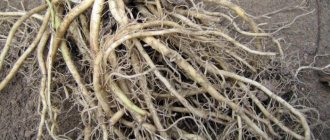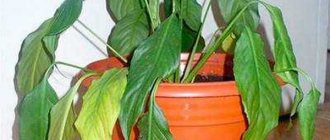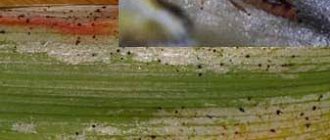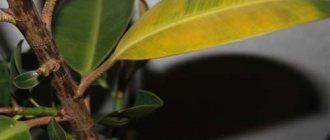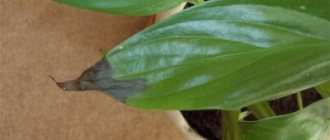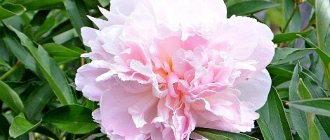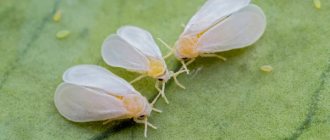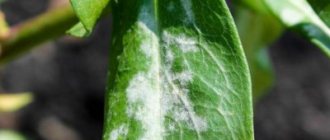Every gardener has encountered the problem of dry leaf tips in indoor plants at least once. It doesn’t matter whether you grow begonias, spathiphyllum, roses or orchids. At the same time, potted flowers do not show other alarming symptoms, continuing to grow and even blooming. Let's try to figure out why the tips of the leaves of indoor plants dry out, whether it is dangerous and how to eliminate the defect.
Most often, yellow, brown and even black dry tips are the result of improper care or a reaction to the activity of pests. The process of natural aging cannot be ruled out. True, the latter can be delayed by creating the most comfortable conditions for the green pet.
Diagnosis is an important stage for prescribing the correct “treatment”
To determine why the leaf tips of spathiphyllum, geranium and other plants turn yellow and dry, diagnose the condition of your green pet. The complexity of the procedure lies in the fact that the search for the cause most often has to be carried out from the opposite direction, i.e. by exclusion method.
- Make sure that the depressed state of the plant is not caused by pests . They like to hide on shoots and on the undersides of leaves, so inspect these places especially carefully. Parasites can also be on the roots. But don't rush to check it out. Perhaps the reason is completely different, and you will only damage the root system in vain.
- Assess the hardness of the water used for irrigation . If you do not settle tap water before watering, plants may suffer from high levels of salts, fluoride, chlorine and other heavy substances that change the characteristics of the soil, making the substrate uncomfortable.
- Compare your fertilization schedule to the recommended fertilization schedule . The reason why the leaves of palm trees, dracaena, ficus, orchids and other crops dry out may be frequent or, conversely, rare feeding.
- Measure air humidity levels . Assess how much air humidity in your apartment is suitable for moisture-loving species.
- Analyze whether the plant is cramped in the pot . One of the alarm bells may be roots emerging from the drainage hole.
- Determine the moisture content of the substrate and the degree to which it dries out between waterings . This can be done either by touch or using indicators that are sold in flower shops.
If you find a deviation from the norm in just one point, the cause of dry ends is usually easy to eliminate. But if, after a preliminary analysis, you see several problems at once, you will have to take comprehensive measures.
Mild blanching of leaves: symptoms, causes and methods of control
A mild degree of chlorosis or general blanching of the leaves is clearly noticeable against the background of a general depressed state. Withered and discolored leaves stand out against healthy houseplants, the appearance becomes increasingly dull and sickly, the plant resembling a pale version of its former beauty. Dull color, discoloration, blanching of only part of the leaves or a separate area of wilted leaves indicate various problems with the health of the plant.
| Signs of a problem | Cause of withering |
| Flabby leaves that have lost turgor are combined with a dull color; without timely measures taken, the leaves sag more and more and brown spots grow on them; in a neglected state, some of the leaves fall off | Excessive watering and the spread of root rot |
| Pallor or complete discoloration (uniform throughout the entire crown or expressed to varying degrees), the appearance of watery, dark areas, a limp, drooping appearance | Hypothermia or frostbite |
| The sluggish appearance is combined with discoloration of both leaves and shoots; gradually the depressed state is complemented by stretching of the plant and shrinking of leaves | Low light |
| A lethargic-looking plant first becomes discolored, and then the leaves begin to turn brown and die | Thrips infestation |
| The plant seems pale and lethargic, it is in a neglected state, the leaves along the crown unevenly turn pale, turn yellow and dry out | Spider mite infestation |
| Droopy leaves do not turn very pale, but the plant becomes deformed, dwarfism develops and signs of growth problems appear. | Nematode damage |
| Slow discoloration starting from the bottom of the crown and from the leaf veins, which gradually gives way to yellowing and browning of the leaves | Nitrogen deficiency |
| Discoloration of the reverse side of the leaf blades between the veins, gradually covering the entire leaf and turning into purple washes along the edges of the leaves | Magnesium deficiency |
| Blanching of the lower leaves, sharply turning into browning | Potassium deficiency |
| Blanching of the upper leaves, sharply turning into browning in a neglected state | Iron deficiency |
| Blanching of the base of old leaves and the tips of young leaves, which gradually turns into leaf death | Boron deficiency |
| Discoloration of the tissues of the leaf blade only between the veins with gradual yellowing and repainting to orange | Manganese deficiency |
| Pale spots on leaf blades, which in a neglected state turn into specks of rusty spots, and repainting in a bronze tint | Zinc deficiency |
Particular care should be taken in choosing the method of treating a plant when it is damaged by pests and diseases. It is always better to try to deal with this problem by washing, correcting care and biological methods before using chemicals. But if the damage is serious or the situation worsens, insecticidal preparations are the only chance to save the plant.
Methods of dealing with problems are directly determined by their cause:
- Correction of watering helps only at the initial stage of wilting. If the leaves turn pale, then the only measure to combat rot and dampness that led to wilting is an emergency transplant with the removal of damaged tissue. This same method, albeit risky, is a chance to get rid of the consequences of soil contamination by nematodes.
- Increasing the temperature and removing damaged leaves and shoots will help save a plant that has suffered from hypothermia.
- Additional lighting or a light sanatorium will help solve the problems of insufficient lighting levels.
- Infusions of onion and garlic or insecticides (selinon, karbofos, decim, potassium soap) will help cope with thrips damage.
- If the depressed appearance of a pale plant is caused by spider mite infestation, then simply increasing the humidity will not be enough to combat the problem. Moisture treatment for tropical plants, the use of decoctions and infusions (tomato tops, wormwood, chamomile, dandelion) and insecticides (from karbofos to pyrethrum, carbolineum, acaricide, potassium soap) will help cope with the various stages of spider mite infestation.
- The application of highly specialized and monofertilizers (nitrogen, potassium, boron, etc.) helps to cope with blanching and wilting caused by a lack of certain macro- and microelements.
If the depressed state of the plant is associated with problems that cannot be solved, for example, severe frostbite or rotting of the base of the shoots, then it may not be possible to save the plant. Cutting cuttings and rooting them will help you grow a new plant to replace the old one.
Wilting houseplant
Let’s start “treating” indoor flowers: general rules
Regardless of the reason why the leaves of anthurium, Kalanchoe or chlorophytum dry out, any plant could use emergency help, which consists of the following:
- Replacing the surface layer of soil with fresh substrate . This will reduce the risk of soil contamination and eliminate salt deposits from hard water.
- Cleaning the surface of leaves from dust . For plants with delicate leaves, this can be done using a shower. If the leaves are denser and not prone to mechanical damage, use a soft cloth.
You should avoid bathing in the shower if the leaves of plants have edges (such as those of violets).
- Change in air humidity . Spraying, a humidifier, or a regular container of water placed next to the flower will help with this.
If you suspect that the plant has been flooded, do not increase the humidity until the soil dries out.
- Revisiting principles of care . Make sure the plant is getting exactly what it needs from you. Each green pet is individual, and therefore, the care program needs to be selected individually.
Prevention measures
Prevention for apple trees is simply necessary:
- Thus, cleaning up fallen leaves on an autumn day is a preventive measure against the dispersal of spores of putrefactive fungi and other infections. It’s a good idea to burn such leaves , and then use the fire ashes as fertilizer when digging up tree trunk strips.
- Disinfecting instruments with chlorhexidine and treating wounds with varnish is also prevention.
- As well as killing weeds, clearing dead bark from the trunk.
- Spring treatment with fungicide on swollen buds or copper preparations on the “green cone” of apple trees, and after flowering - a single treatment with broad-spectrum insecticides is also prevention.
- As well as timely feeding with microelements.
Be careful with chemicals and do not use them when ripening apples!
Attention! A large application of “organic nitrogen” undermines the health of apple trees and makes them “tasty” to aphids !
Reason #1. Dry air in the apartment
Many representatives of tropical latitudes, for whom warmth and high humidity are the norm, have moved to live in our apartments. But creating such conditions at home can be extremely difficult, especially during the heating season, when the already dry air dries out completely.
Don’t think that you can save the situation by increasing watering. By doing this, you will only achieve rotting of the root system, and therefore, the leaves will receive even less moisture.
The following methods will help increase humidity:
- Spraying . It is advisable to irrigate the leaves with a spray bottle at least 2-3 times a day. Otherwise, this measure will be ineffective.
Spraying is not suitable for plants with blooming flowers (drops falling on the inflorescence can cause it to wilt), as well as for species with pubescent leaves.
- Use of humidifiers indoors . Using a humidifier you can very quickly increase the humidity to the desired level.
- Place the pot on a tray into which wet moss, pebbles or expanded clay are placed in advance . The bottom of the pot should not come into direct contact with the liquid. Moisture from the pan will evaporate, increasing the humidity locally.
- Finding a new place for plants, away from heat sources . If possible, install regulators on the radiators so that the heating intensity can be reduced.
- Temporary transfer to the bathroom or kitchen . In these rooms the air humidity is always higher than in other parts of the house.
The plum blossomed and dried out - the cause is moniliosis
We often see a plum overwintering well, waking up on time, blooming, even bearing fruit, but suddenly it begins to dry out and die. It happens that the period from the appearance of the first withered leaf to the complete death of the tree takes no more than a month.
A characteristic symptom of moniliosis is as if the leaves were scorched by a fire.
Monilial burn or moniliosis is a disease that mainly affects stone fruit crops. Infection
occurs during the flowering period of the plum, the pathogen (Monilia cinerea) penetrates into the plant through the pistil of the flower. Most often, fungal spores are carried by pollinating insects, but sometimes a gust of wind is enough for infection to occur.
You should not assume that if the plum tree is not infected during flowering, then the threat has passed. A tree can get sick both during and after flowering.
Signs of moniliosis in plums:
- leaves lose their thickness;
- the current year's shoots wither;
- the ovary dries out and crumbles;
- shoots dry out.
Moniliosis is difficult to treat. The fungus Monilia cinerea, which causes the disease, belongs to the division of ascomycetes, which are distinguished by their tenacity. Depending on conditions, they can reproduce either by spores or sexually. If you do not carry out preventive work and timely treatment, you will lose all the trees in the garden within a few seasons.
Treatment involves removing diseased shoots, capturing 7–10 cm of healthy branches, and then spraying the trees with Bordeaux mixture or copper-based preparations at least 3-4 times per season. As an alternative means, you can use more modern and effective drugs such as Horus and Skor.
Just a few decades ago, moniliosis on plums was found only in warm regions with a long, wet spring period. Now the habitat of the pathogen has become much wider, and now even stone fruits growing in Siberia and the Urals are affected by the disease.
Reason #2. Watering indoor plants with hard water
Tap water is usually too hard to water plants with. Moreover, even when settled, green pets do not always like it, because... may contain a lot of salts.
If the reason why the leaves of spathiphyllum, begonia, dracaena, and roses dry along the edges lies in the quality of water, you can suspect the problem by a white coating on the top layer of soil. In this case, you need to proceed as follows.
- Remove plaque (if any) . Try not to damage the root system. Add fresh substrate to the pots.
- Check in the reference book what the plant prefers to “drink” . Perhaps he needs particularly soft or slightly acidified water.
- Avoid watering with running water completely . Be sure to let tap water sit for at least 24 hours (preferably several days). It would be a good idea to strain the liquid before use. If the hardness of even settled water is not suitable for plants, replace it with boiled, melt or rain water.
Subtleties of determining causes
As you know, 50% of a successful outcome for a tree depends on the correct diagnosis.
For a more correct diagnosis , one must take into account:
- Soil condition,
- Proximity of groundwater,
- Their salinity
- The presence or absence of elements and trace elements,
- Quality of overwintering,
- Manifestation of various diseases .
Without this, it is impossible to say for sure what caused the dry top or other type of drying out of apple trees.
The reasons why apple trees dry out can be divided into three groups:
- Negative effects of atmospheric conditions ( frost damage, burns ),
- Fungal diseases
- Pests of bark and cambium.
Reason #3. Violation of the plant watering regime
When asked why the tips of leaves dry out on dracaena, “female happiness,” anthurium, and arrowroot, they usually answer that the plant is overdried. However, not only excessive drought, but also excessive watering can cause this cosmetic problem.
Most indoor plants tolerate temporary “drought” much better than overwatering.
Sometimes it is difficult to understand whether a plant is flooded or too dry. When overmoistened, the leaves lose turgor and look lethargic and lifeless. They seem to be lacking moisture. This is true. The only reason is that the root system is rotten, which means it cannot deliver water to the leaves.
The lower the air temperature in the room, the more dangerous is overwatering.
If you suspect that you have dried out or overwatered the plant, follow our recommendations.
- Check the plant's water needs. Find out whether it needs scanty or abundant watering, and whether it matters if the soil clod dries out between waterings. Also check which method of watering the flower prefers - standard or in a tray.
- Analyze the quality of drainage and drain holes . Overmoistening, which results in rotting and deterioration of the air permeability of the soil, can be caused by a hole in the pot that is too small or a lack of drainage. If so, repot the plant. If there are no problems with drainage, let the earthen ball dry out almost completely, and only then water the plant.
- During drought, water more often and more abundantly . But do not let the liquid stagnate in the pan. Carry out the next watering after at least a few inches of the top layer of soil have dried out - for moisture-loving crops and after the middle layer of soil has partially dried out - for succulents and other low-drinking species.
- Consider buying a pot with self-watering . This invention will save you from the hassle of individually selecting the frequency of watering for each plant.
- Buy a soil moisture meter . Use the device every time before watering to understand how much water the plant needs.
You can water a flower regularly, but it will still suffer from thirst if the amount of water remains insufficient. The surface of the soil may remain wet, but the liquid will not reach the roots. It is not difficult to make sure that moisture reaches the roots. Just pour water until it starts to seep into the pan.
Reason #4. Plant oppression by pests
If pests are noticed on the leaves or stems, this may be the main cause of the yellowed tips. The parasites drink the cell sap, thereby infecting the leaf. In this case, treatment measures must be taken as quickly as possible, because The problem may not be limited to dry ends alone. In addition, the plant can infect its healthy neighbors.
In addition to parasites such as aphids, scale insects, and spider mites, gardeners should also be wary of fungal diseases. They destroy leaf after leaf until the plant is completely destroyed. The fungus can often be recognized by the brown spots that accompany wilting and drying of the leaves.
Complex therapy includes the following stages:
- isolation of the diseased plant from other crops;
- washing the leaves with soapy water;
- increased air humidity;
- application of insecticides;
- disinfection of pots before replanting.
Since the diseased plant may have come into contact with other crops, strengthen safety measures for other indoor flowers.
The best protection against pests is prevention of their occurrence. Therefore, always treat the pots before planting, use only packaged soil or calcine garden soil. And never place recently purchased flowers next to the permanent inhabitants of your home flower garden. Isolate “new arrivals” for at least a month to ensure they are healthy.
Reason #5. The pot is too small for the flower
Brown leaf tips may appear if the plant is planted in a pot that is too tight. By the time the roots have taken over the entire space of the flowerpot, the soil will have already been depleted, which means that the flower will be sorely lacking in nutrition. Finding out if this is what caused the problem is easy. If roots are already visible from the drainage hole, then an emergency transplant is required.
Reason #6. Lack of light or direct sunlight
Incorrect placement can also cause leaf tips to turn black. Moreover, both too bright light (direct sunlight) and lack of lighting lead to a similar result.
When trying to understand why the leaves of flowers dry out, it doesn’t hurt to analyze whether direct sunlight burns the plant. This provokes the appearance of not only brown tips, but also entire spots. This phenomenon occurs especially often after spraying on a sunny day.
Yellowing due to lack of light looks different. It manifests itself as an uneven loss of color and may be accompanied by the dropping of leaves (hibiscus behaves this way most often).
- Find out which window (north, east, southwest, etc.) the flower prefers to grow on, and try to find a suitable place for it.
- If it is not possible to place the pot on a bright window, get an additional lamp. This can be a special phytolamp or a regular fluorescent one.
- If the leaf tips are turning yellow on only one side of the flower, try rotating the pot from time to time to ensure all shoots receive enough light.
- Protect the plant from bright sunlight using blinds or regular cardboard (its size should correspond to the height of the flower), which should be placed between the window and the flower pot during the daytime.
The apple tree dries up in the spring: what to do
Rules for caring for an apple tree in spring
The gardener has a lot to do in the spring so that the apple trees will be pleased with an excellent harvest in the fall. Work in the garden begins as soon as the air temperature during the day is not lower than +10 C (early-mid-April), and the likelihood of night frosts is minimal. Spring apple tree care consists of the following activities:
- The tree is freed from winter insulation and shelters;
- The area around the tree trunks is cleared of last year's fallen fruits, leaves, and branches. Such cleaning is necessary not only in autumn, but also in spring.
- Inspect the trunk and branches for damage. If the wounds are superficial (for example, cracking and peeling of the bark), then it is enough to remove the damaged bark and treat it with garden varnish.
- If there is serious damage to a trunk or branch, for example by rodents, the exposed wood is carefully cleaned and covered with garden varnish, and then wrapped with burlap.
- The apple tree is pruned before the buds appear. Remove damaged and weak branches and growths. Formative pruning avoids splitting of the main trunk.
Important! Before you start pruning apple trees, you should read the recommendations and advice of experts and watch thematic videos on the Internet. Incorrectly performed spring pruning will greatly weaken the tree and reduce its yield and resistance to diseases and pests.
- After pruning, they begin to whitewash the trunk and skeletal branches. For this purpose, solutions of lime, chalk, and copper sulfate are used. Sometimes acrylic paint is applied to the trunk as a protective layer, which is more resistant to rain and frost. These are the main tasks that a gardener performs every spring.
Rules for caring for an apple tree in spring
However, very often in the spring, gardeners, when examining an apple tree, discover drying out of both its individual parts and the entire tree. This situation requires taking immediate measures, but before them it is necessary to understand why the apple tree dried up after winter, because the choice of measures that will reduce the consequences of this phenomenon not only in the current year, but also in subsequent seasons depends on the reason.
Determining a specific cause is not easy.
First, let's look at a few general points that can lead to the apple tree drying out throughout the growing season:
- Features of the soil in the garden plot;
- Shallow groundwater table;
- Lack or complete absence of elements and trace elements;
- Influence of climatic and atmospheric conditions;
- Manifestation of fungal, viral, bacterial diseases;
- Presence of dangerous pests.
After wintering, the apple tree can either partially or completely dry out due to:
- Severe frosts, lack of snow cover;
- Insufficient cover of the tree trunk circle;
- Bacterial disease root canker.
Damage to the apple tree caused by the reasons described above has a number of negative consequences:
- Freezing of the trunk and root system leads to drying out of a healthy apple tree after winter.
- Cancerous growths on the root and its lateral processes rot in the fall, completely destroying the root. The tree dies in the spring.
If the apple tree dries out in spring or June
If an apple tree dries up in the spring, what to do to save it, the gardener can decide only after he determines the cause of the drying of the branches, top, and leaves of the trunk. Let's look at each of these cases in detail.
The main reasons for drying of apple tree branches are:
- waterlogging of the trunk circle with groundwater;
- excessive accumulation of water from melting snow;
- lack of nutrition.
Consequences
- Excess moisture prevents air from reaching the root hairs, which provide the entire tree with nutrients;
- Due to lack of nutrition, the branches of the apple tree begin to dry out gradually.
The apple tree dries up in the spring
The top has dried up
Drying of the top of the apple tree occurs due to reasons such as:
- High groundwater table;
- Flooding of the trunk circle and root system with melt water in the spring during sudden warming;
- Lack of nutrition (nitrogen, phosphorus or potassium starvation).
- Overmoistening of the soil leads to rotting and partial death of the root system, which leads to dry tops.
- Due to insufficient amounts of certain nutrients (nitrogen, potassium, magnesium, calcium), the plant shows signs of starvation. The tops are starting to dry out. For example, if the top of a young apple tree is almost half dry, it means it does not have enough nutrition to grow.
Leaves are drying
On a plant with a damaged root, not only the branch, the top, but also the leaf becomes dry and lifeless.
But the main reasons for foliage drying out are:
- Scab - leaves become covered with an oily coating, brown, gradually growing spots appear;
- Powdery mildew - the leaves first become a dirty gray color, then dark brown;
- Rust - bright brown spots with black dots appear on the leaf plate;
- Black cancer - the leaves become covered with black spots, black ulcers and rot appear on the branches and bark of the trunk. This insidious disease can destroy all parts of a tree in a short time. Often this infection becomes the reason why apple trees on the site die if they are well cared for.
- Lack of nutrients: potassium, zinc, magnesium, calcium.
Consequences
The leaves begin to wither and dry out prematurely. The apple tree does not bear fruit.
Flowers are drying
- Lack or absence of minerals;
- Fungal diseases (powdery mildew, black cancer or sooty fungus);
- Presence of pests (aphids, ants, mites).
Consequences
During the flowering period, the plant requires increased nutrition. But if any individual nutrient element (nitrogen, phosphorus, potassium) is not contained in the soil, then the annoying fall of flowers and drying of buds begin. Flower buds that are severely affected by diseases or pests may not bloom at all. All this will lead to the fact that the future harvest will be at risk.
- If a young branch is covered with aphids (just take a good look), then the flowers dry up before they have time to bloom.
- Black cancer is an insidious disease. It destroys all parts of the tree. The petals turn brown, the pistil and stamens become black.
- The central trunk has dried up
Causes
- Proximity of groundwater;
- Accumulation of surface water;
- Complete freezing of roots in winter;
- Bacterial cancer (growths, compactions on roots);
- Insufficient insulation of the trunk for the winter.
Consequences
Overmoistening of the soil near the trunk has a detrimental effect on the roots. The root system infected with bacterial cancer also does not survive. Without a root, the main trunk dies and it is almost impossible to save the tree.
If the trunk of the apple tree is not properly insulated for the winter, cracks may appear in severe frosts. The capillaries of the trunk and the fibers of the bark die.
All the buds have dried up
Causes
- Presence of disease (powdery mildew);
- Exposure to winter and spring frosts;
Consequences
If buds damaged by powdery mildew are not treated in time, they may die and the tree will not bear fruit.
Both in winter and in spring, the buds can suffer from frost. How to reanimate an apple tree if all the buds have dried will be described below.
Half the apple tree has dried up
Causes
- Proximity of groundwater;
- The main trunk was not insulated for the winter;
- Presence of rodents (mice, moles).
Consequences
Due to partial death of the roots as a result of freezing, getting wet, and damage by rodents, part of the apple tree, sometimes even half, dries out.
The apple tree has dried up, but a new sprout has emerged from the root.
When a tree cannot be saved, it dries up. But even in this case, the apple tree can be revived if a small root still remains in the ground, from which a small shoot can emerge. But this wild tree will not turn out to be a real fruit-bearing tree - the fruits will be small, tasteless, and the branches will be strewn with thorns. In order to get a cultivated tree for wild use, you need to graft part of the cultivated variety - a shield with a bud, a cutting.
The apple tree has dried up, but a new sprout has emerged from the root.
Thus, each of the above reasons can be the answer, for example, why and why the apple trees are dying this year on the site.
The apple tree has dried up after winter, what to do?
At the first signs of a plant being damaged by a fungus or bacteria, treatment begins:
- For powdery mildew, spray with a solution of fungicides (Hom, Skor, Topaz);
- To treat scab and rust, the following drugs are used: Fitosporin-M, Horus, Gamair, etc. Spraying with Bordeaux mixture (1%) is carried out at intervals of 2-3 weeks. For rust, 3 treatments are enough; to treat scab, up to 7 sprays will be required.
On a note. To prevent burns when processing buds, young leaves, buds and flowers, use Bordeaux mixture with a solution concentration of no more than 1%.
Gardeners often resort to simple means. For example, you can make solutions for spraying trees yourself from copper sulfate (5 g per 10 l of water), baking soda (50 g per 10 l).
It is difficult to overcome a disease such as black cancer; it is easier to prevent it, for which a number of preventive measures are performed:
- Diseased branches and leaves are removed, as fungal spores like to overwinter in fallen leaves and fruits.
- Seedlings are carefully selected, examining the roots for the presence of diseased growths. Then in the spring there will be no problem as to why the young apple tree dries out and what to do with it.
To get rid of harmful insects, the plant is sprayed with a solution of drugs such as Decis, Karate, Aktelik, Iskra, Inta-Vir, Fufanon and their analogues. For common rodents and moles, special potent poisons are used, for example, the drug Ratobor.
The apple tree has dried up after winter
With malnutrition (signs of starvation)
- In spring, the crown is formed correctly, excess branches are cut off so that they do not take away food;
- Flowers, buds, buds are sprayed with the following preparations: Skor, Epin-extra, Ovary. Treatment is carried out before the flowers appear, then during the flowering period (May) and when flowering is completely completed (June-July).
- At the end of April and beginning of May, apple trees are fed with nitrogen-containing fertilizers (ammonium nitrate, ammonium sulfate, etc.). In June, superphosphate, potassium sulfate, and potassium nitrate are added. From organic matter, slurry and chicken manure infusion are used.
With waterlogging of the soil, proximity to groundwater
- In the spring, the tree trunk circle is allowed to dry well, for which shallow drainage ditches are installed.
- Places where water accumulates are covered with fertile soil.
With adverse weather conditions
- The central trunk is securely covered for the winter, otherwise the tree may simply not survive the winter, completely freezing out in severe frosts.
- The tree trunk circle is covered with snow.
- For regions with a harsh climate, seedlings of zoned varieties with high frost resistance are purchased (for example, any winter variety - Medunitsa, Grushovka Moskovskaya, Melba, etc.).
On a note. More detailed information about growing conditions and ripening periods of any apple variety can be found in the State Register of Breeding Achievements approved for use.
Prevention
In order not to encounter the problem of why the apple tree dries out and what to do in this case, preventive measures are needed:
- If in the area where the apple tree grows the aquifer is shallow, then drainage and drainage ditches are needed. You can’t do without adding a mixture of peat, fertile soil, rotted manure, and sawdust.
- By winter, apple tree trunks are well insulated and windproof shelters are installed.
- Mulching is done in the fall. To do this, dry and loose compost, rotted manure, and non-coniferous sawdust (birch, alder) are poured into the tree trunk circle. If the winter is harsh and frosty, then they are additionally covered with snow.
- Plants are fertilized in a timely manner, in compliance with the norms and quantity of fertilizing. When August comes, an adult tree devotes a lot of energy to bearing fruit, so it is fed with phosphorus-potassium fertilizers.
On a note. In the first year, young apple trees are not fed, since when planting the seedlings, all the necessary nutrients are added.
- Spring pruning of branches (sanitary, formative) is performed correctly. Removed and damaged branches are removed from the area, the sections are disinfected and treated with garden varnish and oil paint.
- Trees are checked for the presence of pests and diseases. Modern drugs can cope with any ailment.
In order for the apple orchard to please with an excellent harvest, and for the apple to be appetizing and tasty, the trees need care and attention. Then the branches will turn green, and the buds will bloom and bloom.
Reason #7. Drafts in the apartment
The plant can grow quietly in a cool room. But it will react very poorly to sudden temperature changes caused by cold air masses. Drafts are detrimental to almost all indoor flowers. As a result, slightly yellowish spots appear on the leaves, which fade until they become translucent.
The source of drafts and cold air currents can be not only an open window, but also a running air conditioner or fan. Place the pot where the influence of cold air is minimal, and the flowers will again thank you with lush and juicy greenery.
Reason #8. Incorrect feeding scheme for indoor flowers
Excessive care for houseplants often causes yellowing of the tips. This is especially true for those gardeners who like to apply fertilizers, guided by the principle “the more, the better.” As with watering with hard water, a white coating may form on the surface of the substrate, which needs to be removed. Be sure to stop feeding.
Yellow tips can also signal that you have not fed the plant for a long time or have not taken care of its balanced diet. The lack of elements manifests itself in different ways.
- Potassium deficiency : the tips and edges of the leaves turn yellow, but the veins do not change color.
- Nitrogen deficiency : tips and veins turn yellow. The leaves become smaller and gradually lose their color saturation (even turning white).
- Calcium deficiency : leaf tips turn brown, leaves become deformed and curled. The defect occurs in soils that are too acidic or too alkaline.
- Zinc deficiency : Leaves look like they are sunburnt. They lose color. The veins protrude.
- Iron deficiency : leaves turn yellow and become smaller. The veins retain their green color, but become more convex.
If only the tips of indoor plants dry out, and the leaf blade itself remains healthy, this rarely leads to serious problems. Although, of course, all this spoils the appearance of the flower and the mood of its owner. If it's just a matter of dry air, perhaps everything will go away after the end of the heating season. But if the reason is more serious, then you cannot turn a blind eye to the flower’s disease, so as not to aggravate the situation.
Nuances and questions from readers
If a young apple tree dries up, what should you do?
Branches
If the apple tree does not have enough strength, then its individual branches dry out. Such branches are cut out .
And in the future, such a tree needs:
- Feeding,
- Correct pruning
- correctly formed crown.
It is these conditions that will help the tree redistribute nutrition between all parts of the crown.
Also, all dry parts must be cut out and burned in a timely manner!
Top
- The dried top of the apple tree needs to be cut down to the healthy part and should be painted over with paint.
- Feed the tree with 400 grams of complete mineral fertilizer if it is from 3 to 12 years old, and 600 grams when the apple tree is older.
- You also need to check the roots , and if they get wet, then you need to do drainage .
Trunk
You can try to save the tree by sawing off the already dry part or cleaning the diseased part, and painting over the wounds with oil paint.
If it is cancer or sooty fungus, or tinder fungus, then the question of how to save a dried-out apple tree is inappropriate; it will definitely die.
Proper pruning of an apple tree.
But when this happens due to freezing , then you can make an “apple tree” or wrap the remaining living branches. Because there is no other way to save a delicate variety. It is especially important to decide when a young apple tree dries up, what to do and how to save it.
Advice! First of all, carefully inspect the dry trunk, and only then cut!
Bark
a sooty coating is noticeable on the dry spots on the bark of apple trees and the spots themselves are too large, then rescue measures will be useless. But if these damages are small, then they are cleaned down to living wood and painted over with oil paint.
Sometimes the problem is the death of the cambium due to damping off, and this can be solved by clearing the dead bark and filling the resulting “holes” with varnish.
If fungi or mold , then the tree will be saved by thoroughly “whitewashing” the entire trunk and branches with a concentrated solution.
in spring
If the apple trees bloomed in the spring and then began to dry out quickly, then the following reasons are possible:
- They got very wet
- Mold infestation,
- They were eaten by water rats,
- If this is a steppe region, then they were killed by “winter-spring drying out,” which is also incurable.
If this occurs from wounds, frost holes and burns , then emergency measures can be taken to clean them and seal them with fatty pitch or paint over them with red lead on natural drying oil, and this will save the apple trees.
What are foliar feedings?
What to do when the apple tree dries out only at the ends of this year's or last year's branches? Most likely, the reason is a hunger for microelements:
- Seru,
- Magnesium,
- Iron.
But if “iron hunger” is a rare guest, then other elements in acidic or waterlogged soils are often “in the red.”
That is why young apple trees require timely treatment “leaf by leaf” with solutions containing these substances.
The most suitable preparations for this kind of fertilizing will be “ Kemira-Lux”, “Sudarushka” and the like, you just need to not increase the dose of fertilizing in the solution.
Help apple trees in trouble, and they can live for many more years. And at the same time they will bring a rich harvest of tasty and healthy apples!

